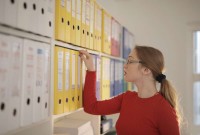- Home
- Business Processes
- Industry Knowledge
- Aerospace Industry
- Automotive Industry
- Banking Domain
- BFSI Industry
- Consumer/ FMCG Industry
- Chemicals Industry
- Engineering & Construction
- Energy Industry
- Education Domain
- Finance Domain
- Hospitality Domain
- Healthcare Industry
- Insurance Domain
- Retail Industry
- Travel and Tourism Domain
- Telecom Industry
- Leadership Skills
- eLearning
- Home
- Functional
- General Ledger (Record to Report)
- What are Management Entities?
What are Management Entities?
In this article we will discuss various types of "Management Entities". Various types of operational units, are created by management, to effectively run, manage and control their business. Different types of functional units, and divisional units, are widely used across industry.
In this article, we will discuss various types of "Management Entities".
Various types of operational units, are created by management, to effectively run, manage and control their business.
Different types of functional units, and divisional units, are widely used across industry.
What are some commonly used, "Management Entities"?
Various types of operational units, functional units and divisional units, that are widely used across industry are.
- Management Entity, or Business Units.
- Departments and Divisions.
- Business Functions.
- Cost centers.
- Profit Centers.
- Business Locations.
- Product Lines.
- Project Area.
Why Management Entities?
Internally, an organization can be structured in many different ways.
A large number of entities, can be created and tracked, depending on the management‘s objectives.
We have seen in our earlier article on Legal entities, that the legal entities are required, to be defined for external reporting, and compliance.
However, Management defines management entities, primarily for driving internal objectives.
They need these operational units, to efficiently manage their business, and effectively run it.
We know that big multinational organizations, operate in a matrix environment.
Management entities facilitate, division of responsibilities, and enables seamless flow of information, across the organization.
By defining required management entities, management can enable, tracking of various operations, financials, or profitability, for each of these entities.
These different views, can enable, granular tracking of business operations, by various dimensions, like, geographies, countries, locations, business segments, product lines, cost centres, functions, COE’s etc.
That's why, these entities are also, sometime referred to as "operating units".
Definition of Management Entity.
Actually, in real business parlance, A Management Entity, could mean anything, that the management wants.
It could be a business division, a specific type of unit, or department, or even a business function.
Some of the attributes, generally associated with management entities are.
Management of Funds; Management entities manage, on a discretionary basis, funds or portfolios, pursuant to a business mandate.
Used for financial reporting, and enables tracking of expenses, at a granular level.
These entities serve independently of legal entities.
Essentially, it is an autonomous, or a semi-autonomous, operating unit.
They are generally created to, meet strategic business objectives.
They help the management to better manage, their business activities.
They are created primarily, to promote business efficiency.
In our next articles, we will cover detailed discussions on, how companies use departments, functions, cost centres, locations, product lines etc., to create different management entities, and reporting dimensions.
Business Functions
An operating unit that represents a category or functional part of an organization that performs a specific task to support business activity, such as sales or marketing to support business development. Used to report on functional areas. A support function may have allocated budgets and may consist of a group of cost centers.
Organization Support Functions
Self-directed activity systems of an organization concerned with establishing and maintaining the organization as an entity. Each organization support function provides support to all functions, business, business support and other organization support functions. For example, corporate finance, IT functions, administration and knowledge management. An organization support function may have allocated budgets and may consist of a group of cost centers.
Cost centers
A cost center is part of an organization that does not produce direct profit and adds to the cost of running a company. Examples of cost centers include marketing & finance departments. It is an operating unit in which managers are accountable for budgeted and actual expenditures. Used for the management and operational control of business processes that may span legal entities.
Profit Centers
A profit center is a part of a corporation that directly adds to its profit, treated as a separate business and for which the profits or losses are calculated separately. This operating unit is held accountable for both revenues, and costs (expenses), and therefore, profits. Different profit centers are separated for accounting purposes so that the management can measure their relative efficiency and profit.
Business Locations/ Countries/ Geography/ Supplier & Customer Locations
Organizations operate from more than one location and may need to track where a particular financial transaction occurred. Some examples of need to track different locations could be transactions through sales offices, factories, subsidiaries etc. Organizations may even need to analyze the financial information based on the supplier’s or customer’s location may require a location segment dedicated to this. However this has very limited application in terms of usefulness. E.g. software companies cater to clients from all over the world & may like to make strategies based on which customer territory contributed how much to the revenue & hence a customer location is an important segment but for a manufacturing organization this will hold no relevance.
Product Lines/Service Lines
Some organizations deal in products which are low in volume but high in value. These organizations would like to analyze their costs & revenue for individual products. They also need to apportion indirect costs & revenues to these products/services so that the financials provide a full picture on product performance. On the other hand, a supermarket dealing in thousands of product might not have any interest in recording every transaction against the individual product or track financials at product level. Further each legal entity in the group may have its own set of released products that it wants to include in transaction documents.
Project Area
Certain organizations have their business models build around project activities. E.g. a property developer may like to have all its cost & revenue against individual projects. These organizations may have multiple projects running under same legal entity. There projects have their own budget & statutory requirements & hence their own trial balance.
Related Links
You May Also Like
-
Global Business Services (GBS) Model
Global business services (GBS) is an integrated, scalable, and mature version of the shared services model. Global Business Services Model is a result of shared services maturing and evolving on a global scale. It is represented by the growth and maturity of the Shared services to better service the global corporations they support.
-
Understand what we mean by GAAP to STAT adjustments. This article discusses the different standards that are used for multiple representations of the financial results for global organizations. Understand the meaning of US GAAP, Local GAAP, STAT, IFRS, and STAT. Finally, understand why accounting differences arise and how they are adjusted for different financial representations.
-
Period End Accruals, Receipt Accruals, Paid Time-Off Accruals, AP Accruals, Revenue Based Cost Accruals, Perpetual Accruals, Inventory Accruals, Accruals Write Off, PO Receipt Accrual, Cost Accrual, etc. are some of the most complex and generally misconstrued terms in the context of general ledger accounting. In this article, we will explore what is the concept of accrual and how it impacts general ledger accounting.
-
An allocation is a process of shifting overhead costs to cost objects, using a rational basis of allotment. Understand what is the meaning of allocation in the accounting context and how defining mass allocations simplifies the process of allocating overheads to various accounting segments. Explore types of allocations and see some practical examples of mass allocations in real business situations.
-
This article explains the process of entering and importing general ledger journals in automated accounting systems. Learn about the basic validations that must happen before the accounting data can be imported from any internal or external sub-system to the general ledger. Finally, understand what we mean by importing in detail or in summary.
-
For any company that has a large number of transactions, putting all the details in the general ledger is not feasible. Hence it needs to be supported by one or more subsidiary ledgers that provide details for accounts in the general ledger. Understand the concept of the subsidiary ledgers and control accounts.
-
GL - Accrued / Unbilled Revenue
Accrued revenues (also called accrued assets) are revenues already earned but not yet paid by the customer or posted to the general ledger. Understand what we mean by the terms accrued revenue, accrued assets, and unbilled revenue. Explore the business conditions that require recognition of accrued revenue in the books of accounts and some industries where this practice is prevalent.
-
GL - Recurring Journal Entries
A “Recurring Journal” is a journal that needs to be repeated and processed periodically. Recurring Entries are business transactions that are repeated regularly, such as fixed rent or insurance to be paid every month. Learn the various methods that can be used to generate recurring journals. See some examples and explore the generic process to create recurring journals in any automated system.
-
Functional Organizational Structures
A functional organizational structure is a structure that consists of activities such as coordination, supervision and task allocation. The organizational structure determines how the organization performs or operates. The term organizational structure refers to how the people in an organization are grouped and to whom they report.
-
Generally Accepted Accounting Principles define the accounting procedures, and understanding them is essential to producing accurate and meaningful records. In this article we emphasize on accounting principles and concepts so that the learner can understand the “why” of accounting which will help you gain an understanding of the full significance of accounting.
Explore Our Free Training Articles or
Sign Up to Start With Our eLearning Courses

About Us
Learning
© 2023 TechnoFunc, All Rights Reserved











